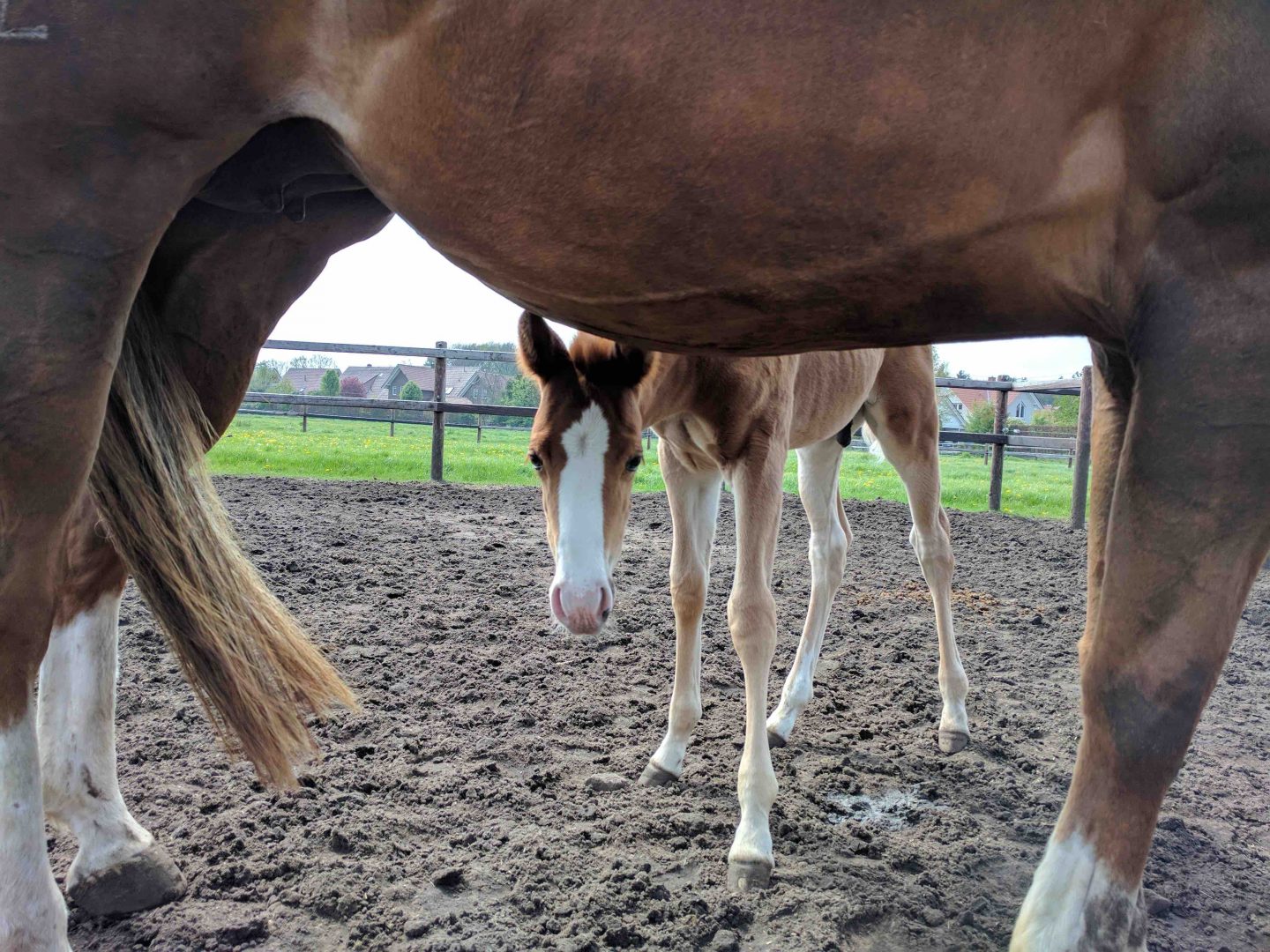From an early age, foals' feet and limbs should be monitored by a farrier, as highlighted by Dr. Riba de Ave's experience.
Faults in the conformation of hooves and limbs that have not been taken care of at 3-4 months accumulate and worsen.
These disorders can cause the horse to have locomotion problems at 4-5 years old when it begins its sporting career.
Pains and poor-performances
Illustration of a case of a 7-year-old horse examined and followed by Rodrigo Riba de Ave, an equine veterinarian practicing in Portugal.
When he was picked up, the horse had bad feet. As with each new horse that enters the customer base, Rodrigo takes X-rays and photos of the feet with the Metron-DVM software, in order to establish a baseline of the animal.

This methodology allows him to ensure an objective follow-up of the orthopedic evolution, which can easily be shared with the owner and the farrier.
Painful on the flexor tendons and the suspensor ligaments, notable overloads were visible on the back of the feet. Collaborative work with the farrier was therefore necessary.
Intended for show jumping, this young horse had the potential to participate in the 7-year-old events. However, it is the condition of his feet that does not allow him to reach the level of his sporting abilities.
“I suspect that his locomotion problems date back several years, they may even have started when he was only a foal.” An observation very frequently suspected by Dr. Rodrigo Riba de Ave. the practitioner.
“It is not uncommon for the problems that we find in the sport horses we follow, to come from a lack or poor management of the limbs and feet when they were only foals.” explains Rodrigo.
For this 7-year-old horse, poor weight distribution for years has led to a retroversion of the coffin bone.
Apart from his painful feet, no other problem has been diagnosed on the rest of the body.
Management of sore hoove in sport horses
For this horse, Rodrigo and farrier opted for the temporary application of compensations to support the rear of the foot.
The use of wedge pads can compensate for an inappropriate foot angle that is detrimental to the proper distribution of loads.
As progress is made, the wedge pad is gradually reduced until it is completely removed when the foot has regained acceptable functionality.
“The reputation of this procedure is not always excellent” admits Dr. Riba de Ave. “It is true that certain precautions must be taken into account when using this method.
For example, the angle of the foot and the angle of the heels with the wedge pads are generally improved, but these corrections are artificial. The real limb conformation is not modified.
The positive point, from my experience, is that it can still help relieve the animal.
After 6 or 12 weeks, I can very often notice that the foot has evolved favorably. By having developed a heel, for example.
The fact that the horse is relieved, then allows me to consider switching to a more classic shoeing.”
Another warning with the use of wedge pads is that they can crush the heels. This situation would be absolutely deleterious because it worsens the situation instead of improving it.
Used wisely and with rigorous monitoring, Rodrigo was able to obtain good results on horses that had not been improved until then.
“For these horses overloaded on the back of the foot, I particularly monitor the toe angle and the angle of the heels. I make sure that progress is good and we correct things very quickly if necessary with the referring farrier.”
Other alternatives can also be studied by professionals for the management of feet with excessively crushed heels. Depending on the case, the recoil of the horseshoe with or without clip, the application of horseshoes upside down, the leather plates... can contribute to the relief and to improve the distribution of the loads.
At the time of his treatment, the horse presented in this article had a negative palmar angle on the left foot of -3.81 degrees.
The angle of P3 on the right foot meanwhile was only 1.05 degrees.
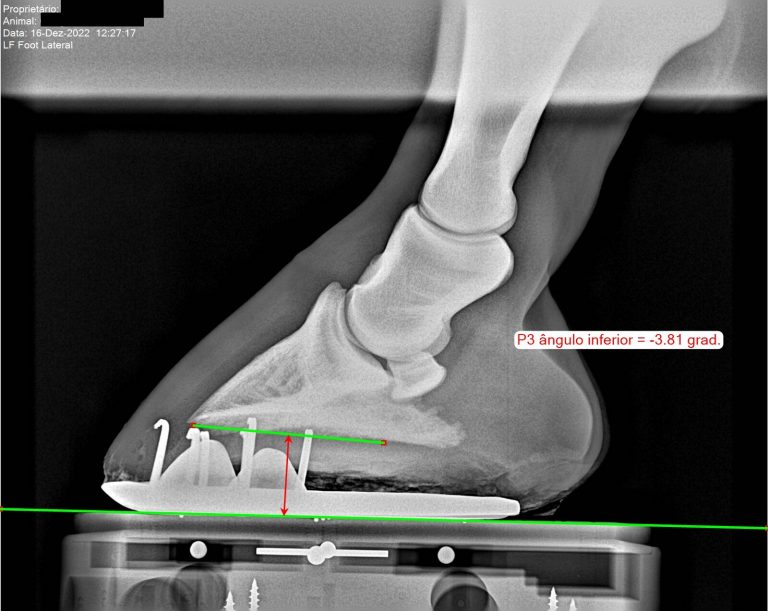
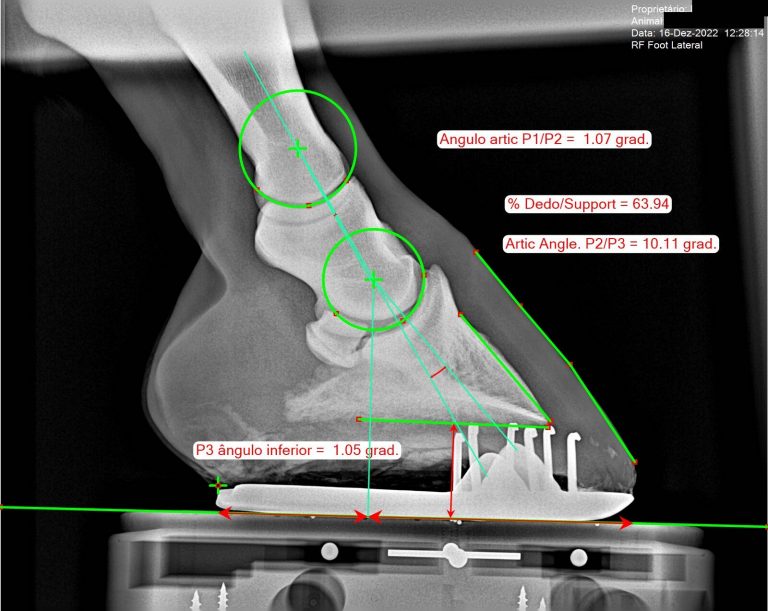


Three days later the horse was examined again. At this stage, only trimming work had been done by the farrier.
An improvement in the positioning of the 3rd phalanx was then already observable on the left foot. The P3 angle went from -3.81 degrees to 1.8 degrees in a single operation.
The application of wedge pads was then recommended during the following 3 months.
The consultation carried out once this period had passed, allowed the veterinarian to observe a marked improvement in the left hoof. The palmar angle being 5.28 degrees. On the other hand, a degradation of the right foot was revealed, with a palmar angle of -1.51 degrees.

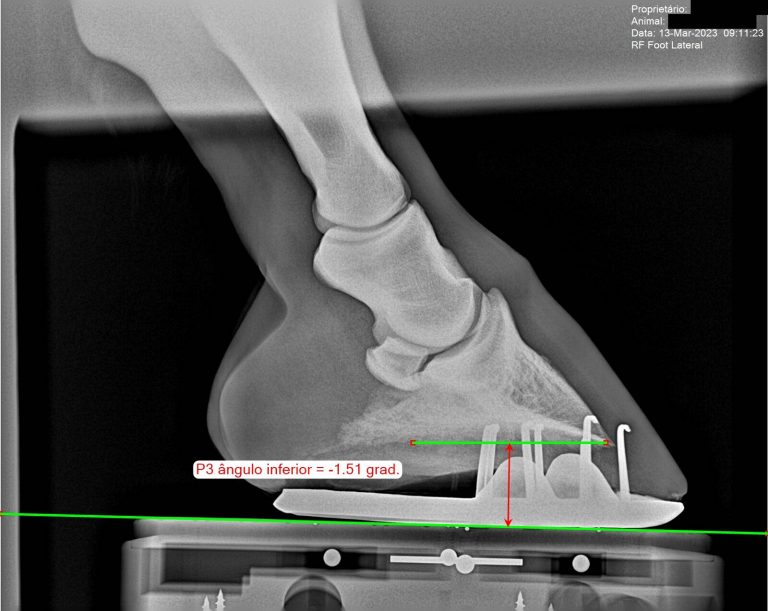
“The problem we faced was that we focused on the most painful foot first. Once that foot was relieved, the other limb got worse.” testifies Dr. Rodrigo Riba de Ave.
Veterinary and farrier collaboration around the athlete horse
With more than 20 years of experience, Dr. Riba de Ave point out the obligation to collaborate with farriers for the management of horses.
The use of data collection or illustration assistance technologies are then of incomparable benefit.
“As professionals, it is not possible to have fixed ideas, you have to remain open, know how to adapt. Otherwise it is difficult to move forward."

By not proceeding in this way during my collaborations with the farriers, there is every chance that they will not listen to my recommendations if they do not agree with me.
You have to keep in mind that it is also a question of their own reputation, which they want to protect by not applying instructions that do not seem good to them as farriers. This seems understandable and normal to me.”
It should be noted that collaborative work does not stop at farriery. All the staff around the horse can have an impact on his health.
For example, the farrier will have to work the feet if the animal is permanently on a dirty stable , malnourished, worked in bad conditions etc. the feet will be bad, for very different causes than that of management in farriery.
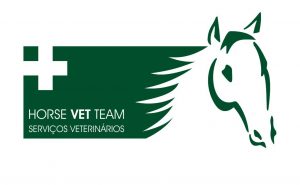
“One of the reasons why I chose Horsevet Team as the name for my veterinary practice reflects this reality. I work alone, but I also work every day with different teams. Those of the horses I examine!
These teams see and take care of the animal every day, this is not my case. Grooms, riders, owners etc. it is necessary to have trust and respect, because they are the ones who take care of the animal on a daily basis.”

